“The river is in ugly shape. The water has turned white, the fish are contaminated, and Indigenous people are sick. I voted for Lula. Most people here are for Lula. Making things better depends on the will of the federal government.” These were the words we heard from Faustino Kaba, 74, elder of Katõ Village, when he received us a few days after the presidential runoffs in November 2022. This community of eight hundred—one of the most populous in the Munduruku Indigenous Territory, in Pará State—lies on the banks of the Kabitutu River, a branch of the Tapajós. Now surrounded by illegal mines, these Indigenous people have witnessed their forest gobbled up day by day, as the destruction approaches their homes and poisons nearby rivers.
Since January 20, when SUMAÚMA reported that at least 570 Yanomami children under the age of five had died of preventable causes during Bolsonaro’s four-year term in office, the world has turned its attention to the genocide of this Indigenous people. Unfortunately, the situation is likewise dire in various other Indigenous territories that have been invaded by illegal miners, and the state urgently needs to intervene there as well. One of the critical areas is the Munduruku territory, where miners have coopted a significant number of Indigenous people. Leaders who defend the forest and traditional lifeways—notably, women like Maria Leusa Kaba and Alessandra Korap—have suffered death threats.
Getting to the Katõ village wasn’t easy. In places where criminal mining operations have advanced over the last four years, the invaders occupy the land much like the militias and criminal factions that now wield control in pockets of Greater Rio de Janeiro and other large cities in Brazil. One day earlier, we had been in Jacareacanga, a municipality with a population of just over 14,000 on the left bank of the Tapajós River, roughly five hundred miles from Santarém and three hours from the village by motorboat. There we met with Arnaldo Kaba, the cacique-general, or chief, and his brother Hans Kaba, who helped us make plans to reach Katõ. The meeting had been arranged by Maria Leusa Kaba, chair of the Munduruku Wakoborũn Women’s Association.
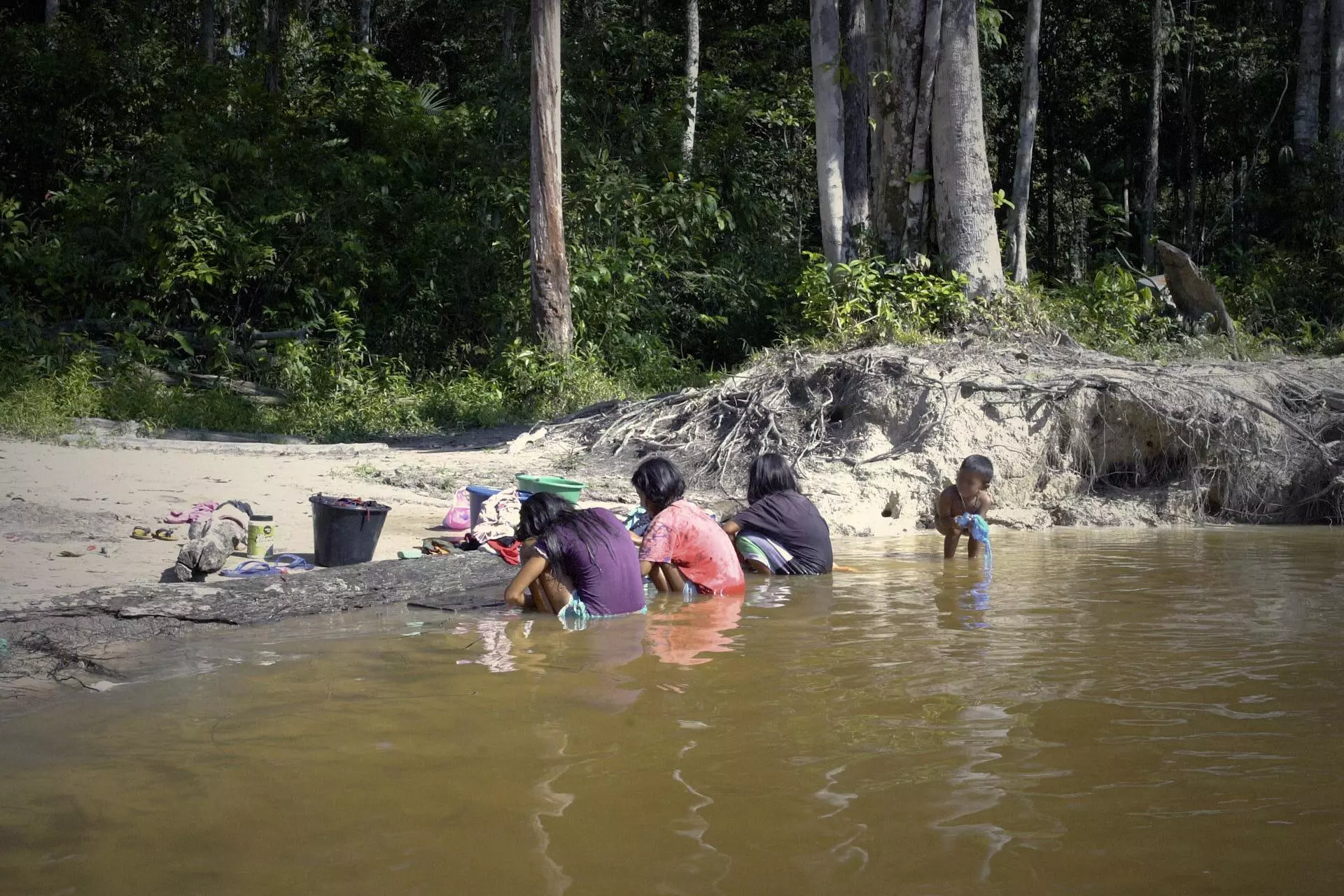
WOMEN AND CHILD IN A RIVER CONTAMINATED BY MINING RESIDUE, IN KATÕ VILLAGE, MUNDURUKU INDIGENOUS TERRITORY, PARÁ STATE. PHOTO: PATRICK GRANJA
Our conversation with the cacique took place at a secluded location on the outskirts of town. We were constantly interrupted by the sound of single-engine planes flying over the house, coming or going from some mining site, according to our hosts. The atmosphere was tense, and the leaders questioned whether we had even minimal conditions to do our assignment. “Mining operations have reached the banks of the river. You can smell it strong in the water. To get to the village, you’ll have to go right through the middle of it all,” Arnaldo Kaba warned us.
His brother, Hans Kaba, former council member and deputy mayor of Jacareacanga, told us he was worried that some of the Indigenous people had been coopted by the miners. “The Pusuru Indigenous Association, once the most important, most representative body for the interests of the Munduruku people, now has ties to the ideas promoted by [Jair] Bolsonaro,” he said. “Indigenous people are divided. Money divides. Politics divide. And the evangelical church clashes with Indigenous culture and divides us as well.” Maria Leusa, who has received death threats because of her fight against illegal mining, told us that a group of Indigenous, backed by white men, had set fire to her home and village in May 2021.
The leaders’ concern was that illegal miners might identify and approach our boat on our way to the village. The murders of Indigenous specialist Bruno Pereira and British journalist Dom Phillips in Javari Valley, Amazonas State, in June 2022, were still fresh in their memories.
We decided to take all possible precautions and risk the trip. We left at six in the morning, hiding our camera equipment for the duration of our journey, which we made with the assistance of one of the community’s most experienced motorboat drivers. We were also accompanied by two young Munduruku, whose names must be withheld for security reasons.
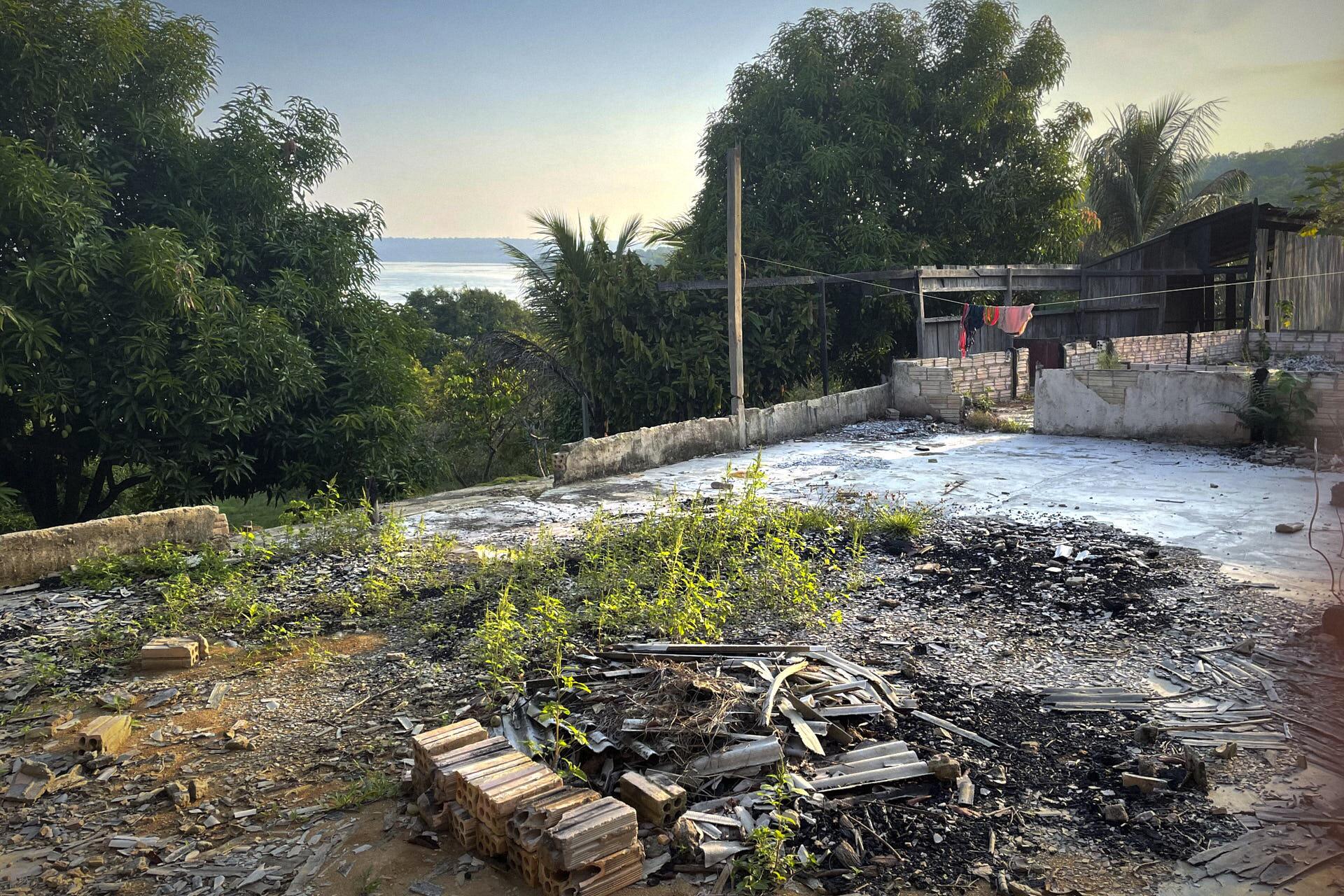
REMAINS OF THE HOME OF MARIA LEUSA MUNDURUKU, BURNED BY PRO-MINING INDIGENOUS AND WHITE MEN. PHOTO: OCTÁVIO FERRAZ
The scene we encountered upon our arrival eclipsed the descriptions provided by the cacique-general, who had last flown over the area with Greenpeace in October 2021. One of the mining sites that we filmed by drone while at Faustino Kaba’s house lies less than 330 feet (100 metres) from the village. When we got there, several children were out playing and women were washing clothes in the whitish waters of the nearby tributary, contaminated by mining tailings.
The impacts of mercury contamination and of other toxic products detected in the water are a source of growing concern as more is learned about them. The Indigenous people are poisoned when they eat fish, a staple in their diet. Children are the most vulnerable, and the problem can reach fetuses in their mothers’ wombs. A number of scientific research studies, such as one by the World Health Organization (WHO), have found mercury can cross the placenta and damage the fetus’s central nervous system, heart, thyroid, and immune system. Symptoms are subtler in adults but no less worrisome: attention deficit, speech disturbances, motor coordination problems, and tingling sensations. Faustino was shaking a lot while talking to our team. His wife, Albertina Korap, couldn’t even speak; she stared at the ground, her body stiff and her head drooping. Could this be the effects of mercury poisoning?
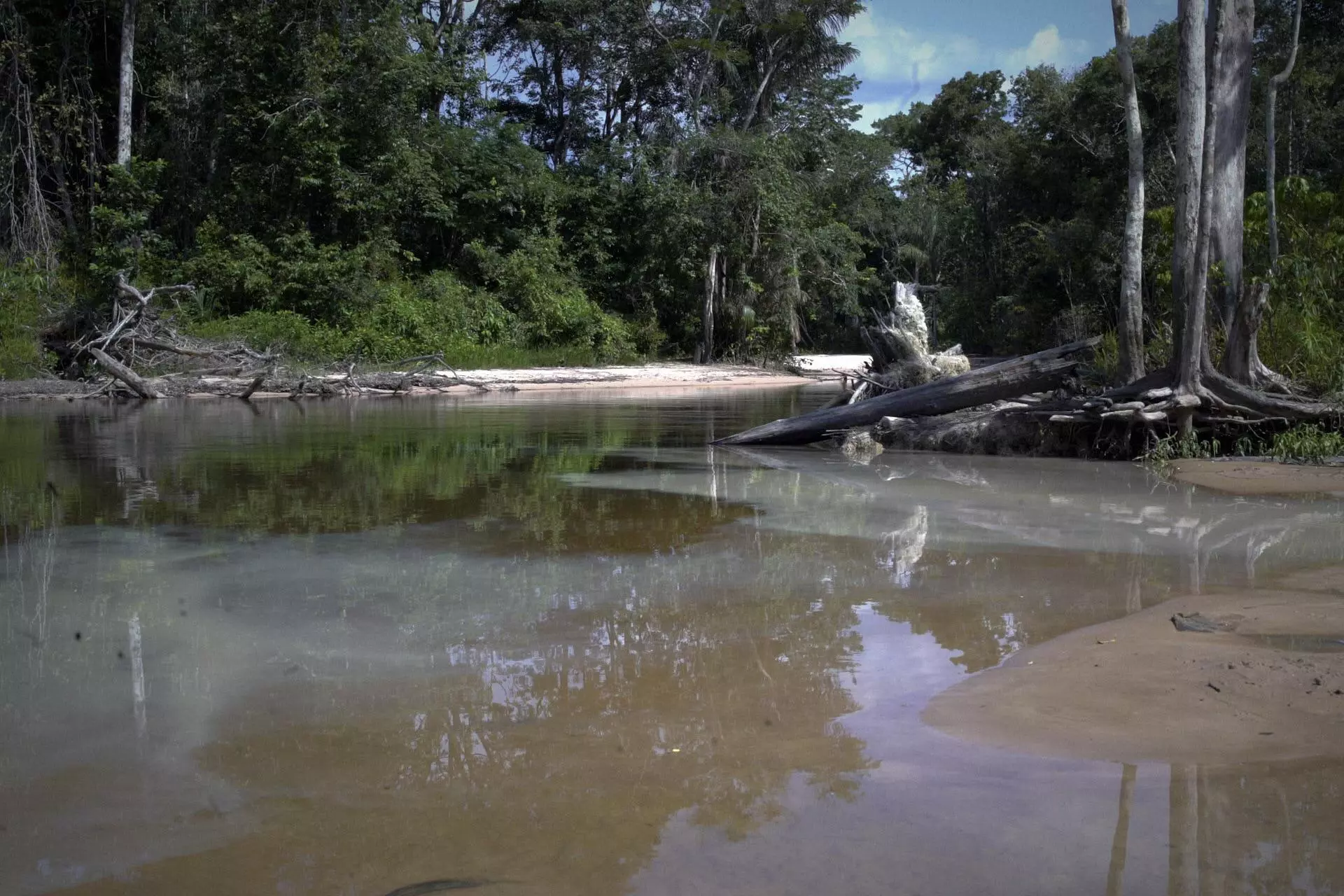
WATER IN THE RIVER LEADING TO KATÕ VILLAGE, TURNED WHITE BY RESIDUE FROM ILLEGAL MINING OPERATIONS. PHOTO: PATRICK GRANJA
In failing to answer this question, the Brazilian State is once again inflicting violence on the Munduruku people. Despite this public health emergency, most residents in affected locations have not been tested —including Faustino, Albertina, and almost everyone else who lives in Katõ Village. “Everybody has mercury poisoning—children, old people, pregnant women. Some are born blind; others have trouble walking. Young people have trouble focusing on their studies. We don’t have any test results, but we can see it,” said Rosinaldo Saw Munduruku, 45, a nursing assistant in Katõ Village. As we listened to him, we thought about the contradictory way things are handled: If mercury contamination were detected in a wealthy neighborhood in some urban area of Brazil, how would the State and the press react?
Widespread testing of the Munduruku population, nearby river waters, and the fish that form the basis of their diet is the least that can be done to start addressing this public health emergency. At the same time, the socioenvironmental devastation must be halted by first expelling the illegal miners who are invading and occupying Indigenous lands and then by taking recovery measures. Although the State has a constitutional duty to protect Indigenous peoples and their ancestral lands and to guarantee their way of life and culture, various administrations have overlooked this obligation, while Jair Bolsonaro completely flouted it during the last four years. The big question now is what Brazil’s new president, Luiz Inácio Lula da Silva, will do. And when.
Erik Jennings, a physician with the Special Office of Indigenous Health (SESAI) in Santarém, cautioned that Indigenous people must be informed immediately whenever illicit mining presents a danger, so they can at the very least know which fish have the most hazardous levels of contamination. “Certain species are more susceptible to mercury than others. Receiving information about which fish to avoid eating is a vital prevention measure,” Jennings said.
In late 2019, a study by the Oswaldo Cruz Foundation (Fiocruz) in partnership with the Brazilian office of WWF analyzed eighty-eight specimens of eighteen species in the region of the Middle Tapajós. It was found that piscivorous species (fish that eat other fish), like the redeye piranha, present the highest levels of mercury. Similar research must be conducted throughout the affected regions and the findings used to craft recommendations specific to each context. As part of this same scientific investigation, samples were collected from two hundred people in three villages: Sawré Muybu, Poxo Muybu, and Sawré Aboy. Nearly 60 percent (57.9%) presented mercury levels exceeding six micrograms (μg) per gram (g), the safety threshold defined in specialized literature.
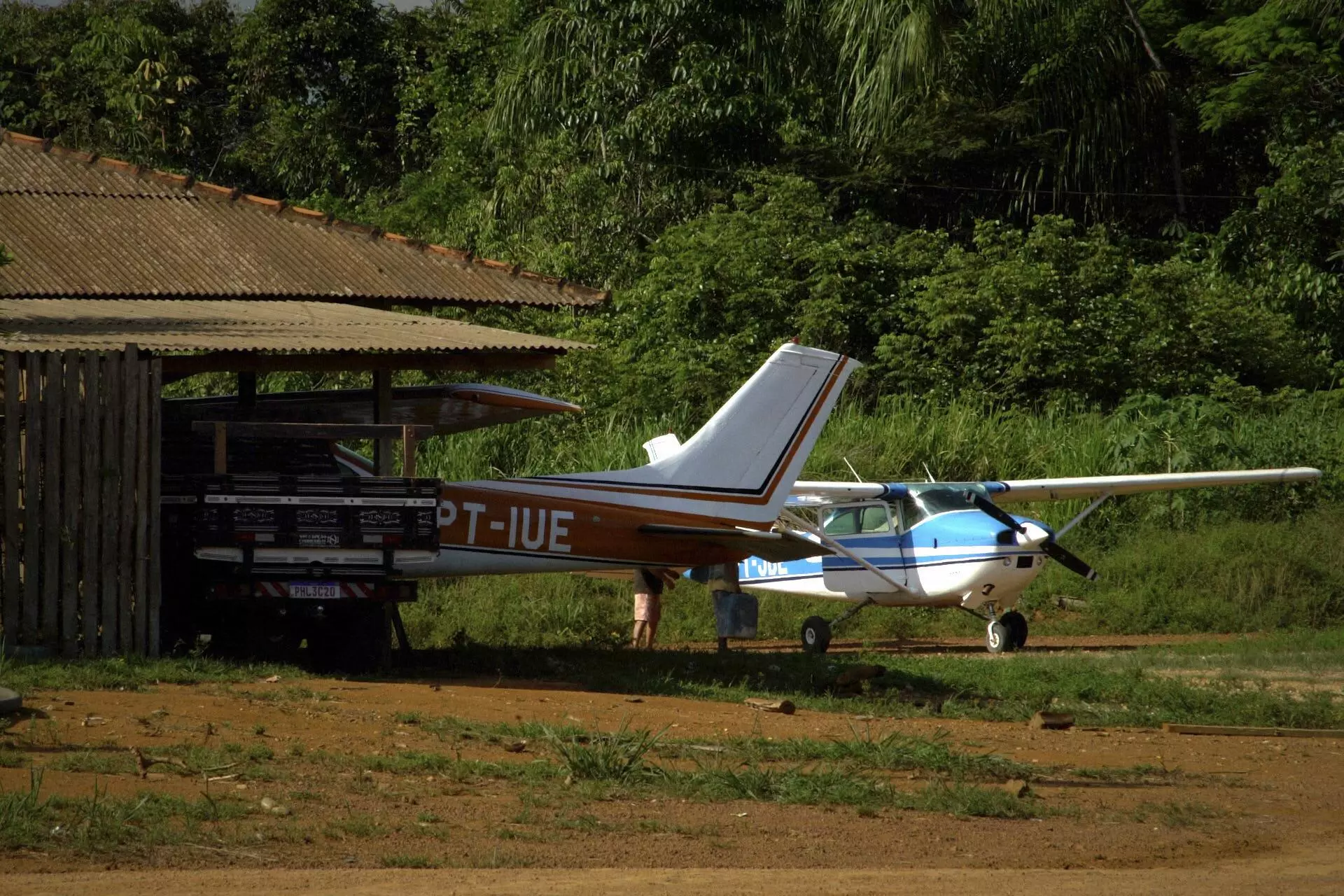
PROSPECTORS’ PLANES AT A MAKESHIFT AIRPORT NEAR FEDERAL HIGHWAY BR-230, IN JACAREACANGA, PARÁ STATE. PHOTO: PATRICK GRANJA
Research on regional contamination is meager and faces serious political obstacles. Scientists have even been the victims of criminal attacks. Jennings led one such study in late 2019; after encountering much resistance right inside the Health Ministry, he managed to collect hair samples from 109 individuals during a meeting attended by members of the Munduruku people from various villages in the Upper Tapajós region. Results found contamination in more than 99 percent of those tested, with some displaying levels fifteen times above WHO guidelines.
When Jennings traveled to Waro Apompu Village with this data, his plane was surrounded at the Jacareacanga airport by pro-mining Munduruku. He was threatened and prevented from continuing his trip, so he hurriedly took off again for Santarém while the crowd hurled stones at his plane. In his office, in October 2022, he told us he hasn’t felt safe to return to the region, so he could continue raising awareness and implementing measures to prevent and protect against contamination. The challenges endured by healthcare teams in areas controlled by criminal mining present yet another serious obstacle.
Larger-scale research is needed to address the public health emergency caused by mercury poisoning. But that is just the first step. The real solution is to combat the underlying disease: environmental destruction. This malady harms not only the health of the Munduruku but their very culture and existence as a forest people. “This makes us so sad. Not only for Indigenous people but for the animals, the fish who live in the water. Enough suffering,” the cacique-general complained.
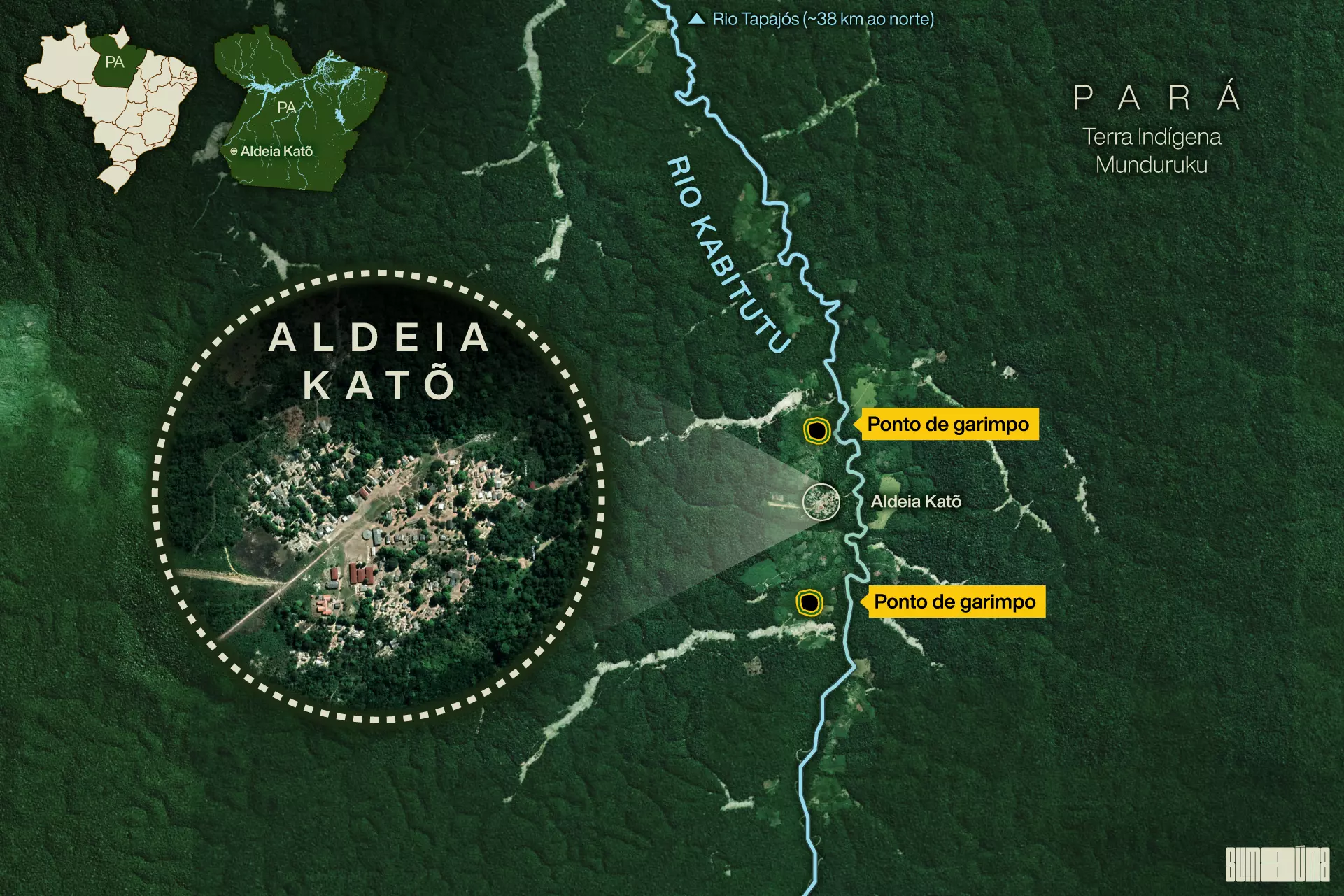
O mapa mostra dois novos garimpos filmados por drone pela reportagem na TI Munduruku, muito próximos da aldeia Katõ. Um deles está a 100 metros e outro a 800 metros. Infográfico: Rodolfo Almeida/SUMAÚMA
Wildcat prospectors came to the Upper Tapajós decades ago. In the late 1950s, immense quantities of gold were discovered there, and exploitation of the mineral intensified in the early 1970s under the business-military dictatorship (1964-1985) and its construction of the Transamazonian Highway (BR-230). But until the late 2000s, mining was mostly semi-mechanized or artisanal, thus limiting damage to the forest and rivers.
When gold prices heated up again in 2008 and high-powered machinery was brought in, especially hydraulic backhoes and payloaders, the structure of mining activities underwent a drastic change, exacerbating the environmental impact. Manufactured by multinational companies such as Hyundai, Caterpillar, Volvo, and Komatsu, this heavy machinery can topple hundreds of trees in a matter of minutes and rip huge craters in the middle of the forest, leaving behind a trail of phenomenal destruction, as shown in the drone images captured by our team.
Paulo de Tarso Moreira Oliveira, a prosecutor with the Federal Public Prosecutor’s Office in Santarém, reported that Itaituba has become one of the largest markets in the world for this type of equipment, although this town on the banks of the Tapajós has a population of just over 100,000. The minutes of a public hearing held at the Itaituba Municipal Chambers in 2019 give an idea of the problem. During the meeting, Roberto Katsuda, Hyundai representative for the municipality, thanked “the mining profession” for his company’s success: six hundred machines sold from 2013 to 2019, with sales ranging from roughly $80 million to $160 million (BRL 300-600 million), since each piece of equipment can cost up to $275,000. Katsuda did not respond to our request for comments.
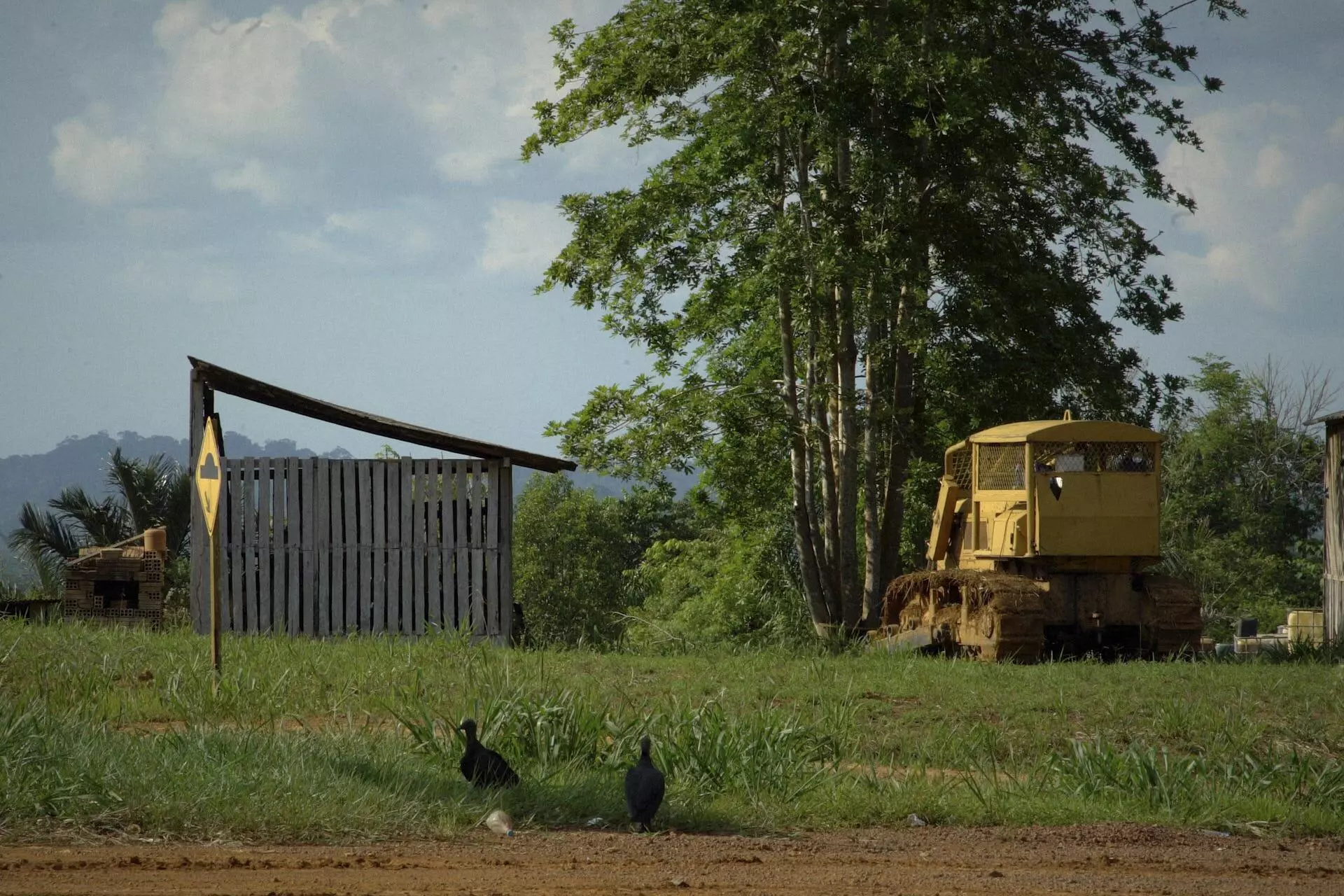
MINING EQUIPMENT NEAR FEDERAL HIGHWAY BR-230, IN JACAREACANGA, PARÁ STATE. PHOTO: PATRICK GRANJA
Anyone who knows Itaituba knows its construction market cannot absorb this much heavy equipment. Other telltale data were uncovered in an investigative report by Repórter Brasil, published in August 2022 under the title “The crime weapon: how agricultural and construction equipment are contributing to the illegal deforestation of the Amazon” (in Port.). The study showed that from 2016 to 2021, Brazil’s environmental protection agency, IBAMA, apprehended 157 pieces of heavy equipment (backhoes, payloaders, tractors, and excavators) at illegal mining sites located inside protected areas in the Amazon, the vast majority on Indigenous lands. Seven backhoes and three payloaders were seized inside the Munduruku Indigenous Territory, while eight excavators were impounded inside Sai Cinza Indigenous Territory. As explained in the report, this is a very conservative estimate, since the study only looked at cases where documents expressly stated that the equipment had been seized inside a protected area.
An increasingly common question raised during discussions of the environmental and climate catastrophe is whether equipment manufacturers are liable for the damage their products cause. If “Lula 3”—as President Lula da Silva’s third term of office has been dubbed—really wants to tackle the problem of illegal mining, this is one possible approach.
Another would be to combat the source of the demand for this equipment, the commercial operations that wield increasing economic and political power. A study entitled “The gold siege: illegal mining, destruction, and struggle on Munduruku Lands” (in Port.), released in 2021 by the National Committee to Defend Indigenous Territories from Mining, tells how Itaituba, a quiet town of just two thousand in 1968, now has some twenty-seven thousand people engaged directly in mining, including the town’s mayor, Valmir Climaco (MDB), re-elected during the first round of voting in 2020 and the owner of a mining operation. Known as the mayor who has managed to legalize the largest number of areas for mining in this municipality, Climaco has close ties to Roberto Katsuda, the Hyundai dealer mentioned earlier, and both are pushing to open Indigenous lands to mining, alongside a number of local, national, and international politicians and businesspeople. This effort enjoys support from upper echelons in Brasilia, including deputies, senators, ministers, and even the former president, who in February 2020 sent Congress a draft bill that would legalize mining and other economic activities on Indigenous lands. Mayor Valmir Climaco did not respond to our request for comments.
Another survey, this one by Agência Pública, reports on the upsurge in the number of applications for mining licenses in the Middle and Upper Tapajós. Ninety-seven applications to mine inside Sawré Muybu territory and twenty-five more inside Munduruku territory were filed between 2011 and 2020. The giant corporation Anglo American Níquel Brasil ranked number one, with forty-six applications, followed by a series of other companies, mining cooperatives, and private individuals, some of whom have been accused of environmental crimes. Over the course of ten years, 656 of these applications involved Indigenous territories in the Amazon in some way. The largest number (130 applications) referred to Munduruku lands, with a high concentration in the lands of the Kaxuyana (50) and Kayapó (42), both in Pará, and Yanomami (27), in the states of Roraima and Amazonas. These applications do not grant the right to carry out mining operations in Indigenous land, because this is prohibited at present, but they do reflect the level of confidence felt by mining entrepreneurs over the last ten years, especially under the former administration. The applications convey a message: investing in these territories, even though they cannot be legally mined, is good for business.
When contacted by our team, Anglo American Brasil stated in a written note that between 2015 and 2021, it had withdrawn all applications involving Indigenous lands. Anglo also alleges that it holds no active mining rights in any area that would interfere with Indigenous territories in Brazil. We requested documentary evidence of these withdrawals but have received no reply to date.
“Where is this gold going?”
The use of heavy machinery in mining operations has had a dramatic impact on the planet’s biggest rainforest, which plays a strategic role in controlling global heating. From 2010 to 2021, mining-related deforestation on Indigenous lands shot up 632%, reaching nearly 50,000 acres. The most heavily hit Indigenous territory is the Kayapó, where 28,500 acres have been destroyed since 2021, followed by the Munduruku, at 11,720 acres, and the Yanomami, roughly 3,850 acres. These data are from MapBiomas.
Based on satellite images, a survey by Greenpeace Brazil found that illegal mining has destroyed more than 370 miles ( 632 kilometers) of rivers in Munduruku and Sai Cinza Indigenous lands, in the Upper Tapajós, since 2016. Prior to that, only 16.5 miles (10km) of rivers had been affected—an increase of 2,278% in only five years. The survey also flagged sixteen airstrips opened in Munduruku territory.
“Where is this gold going?” asked the cacique-general during our conversation in Jacareacanga. A partial answer lies in data from Brazil’s National Mining Agency (ANM). Brazil exports almost all the gold it produces, over 70 percent to just three places abroad: Canada, Switzerland, and the UK. A recent study conducted jointly by the Federal University of Minas Gerais (UFMG) and the Federal Public Prosecutor’s Office describes the inner workings of a strategy used by illicit gold traders to evade oversight. From 2019 to 2020, of the 174 metric tons of gold marketed in Brazil, at least forty-nine metric tons—or 28 percent of national output—were extracted in areas displaying signs of illegalities, a quantity corresponding to roughly $1.754 billion (BRL 9.1 billion).
This is a conservative estimate. Since there is little monitoring of gold sources—because the ANM almost never verifies how much is produced in authorized areas—it is easy to “launder” illicit products by entering false information on papers that document the payment of CFEM, a kind of royalty on mining operations. The fraudsters thus claim that their gold came from a legal mine, when it was in fact extracted from an illegal area. This resembles the procedure used to disguise illegally sourced timber that is the product of deforestation of the Amazon rainforest and other biomes.
Researchers employed an ingenious method to estimate the amount of illegal gold mined and marketed in Brazil. They first gathered satellite images from DETER, a system developed by the National Institute for Space Research (INPE) to detect deforestation in real time. The imagery identified nearly 52,000 acres of mining-related deforestation. They then cross-referenced this information with data on gold origin as reported on CFEM tax forms during this same period.
The findings: in 96 percent of the cases, there were no signs of any mining activities in the locations identified on the tax forms as the origin of the gold, a strong indication that the product comes from illegal mining sites. In the period under study, 12,355 acres of the 52,000 acres of deforested land lay in Indigenous territories, nearly 5,000 acres in Munduruku territory alone.
The study reached a categorical conclusion: the increase in illicit gold mining “coincides with the environmental dismantling that began in 2012 under the Workers’ Party [Dilma Rousseff’s first term] and that accelerated sharply under Bolsonaro, with changes to laws and in the management of environmental agencies, effectively hampering enforcement.” The authors also point the finger at the large gold dealers that benefit most from these environmental crimes and should be obliged to verify product origin.
“Why do you want to destroy us?”
Given the new administration’s campaign promises and those made during the president’s inaugural address—to prioritize protection of both the environment and Indigenous peoples, including a specific reference to combating illicit mining in the Amazon—expectations are high that the situation may finally improve. While Munduruku leaders felt relieved over the election results—because four more years of Bolsonaro would have been ruinous—they are still quite skeptical that any effective change will come. Open sores have been left by mega hydroelectric dam projects on the Amazon, like the one constructed in 2014, straddling the states of Mato Grosso and Pará on the Teles Pires River, a branch of the Tapajós, and the São Luiz do Tapajós project, now shelved. These ventures have been extremely prejudicial to the lives and lands of the Munduruku and yet were pushed through based on questionable court decisions that ignored the legal requirement for prior consultation of impacted populations.
In 2013, Munduruku leaders sent the Brazilian government a letter that expresses the extent of their indignation during Dilma Rousseff’s first term. “Why do you want to destroy us; aren’t we Brazilian citizens? Are we so insignificant? What is the government declaring against us? Are they declaring war to finish us off so they can then hand our lands over to big landowners and agribusiness interests, hydroelectric power plants, and mining? The government wants to take it from us because we’re not making them any profit.”
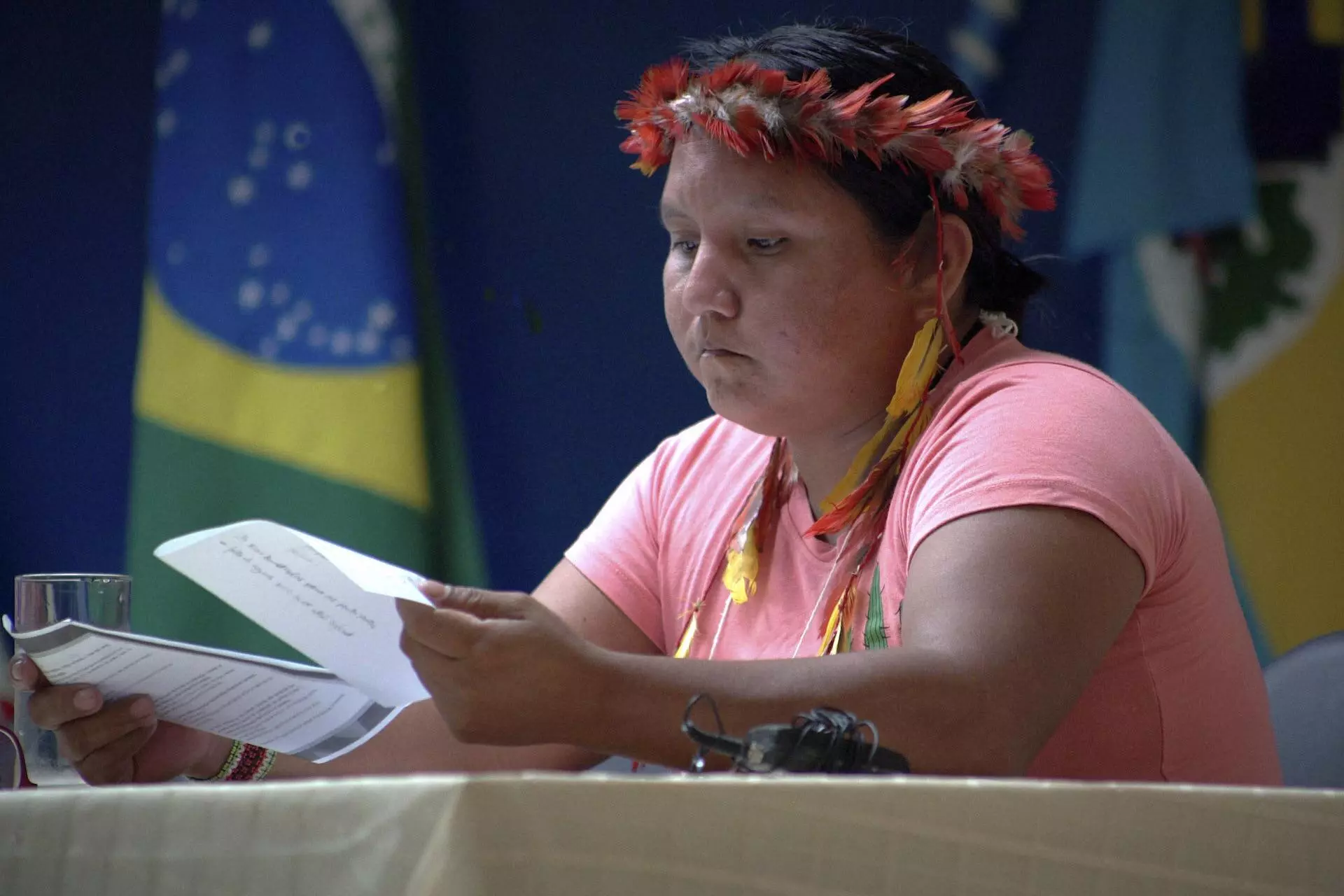
MARIA LEUSA, ONE OF THE FIERCEST, MOST WELL-RESPECTED FEMALE LEADERS AMONG THE MUNDURUKU, SPEAKING AT THE FEDERAL UNIVERSITY OF WESTERN PARÁ, WHERE SHE STUDIES LAW. PHOTO: PATRICK GRANJA
During this new phase of the fight, the Munduruku can count on the strength of female leaders who have emerged in recent years, like Maria Leusa Kaba, 35, and Alessandra Korap Munduruku, 38. The two women have several things in common: their feisty personalities, the death threats they have suffered, and the respect they’ve earned on the frontline of dramatic events in recent years. In 2013, Maria Leusa joined with another 150 Munduruku to occupy the Belo Monte dam construction site on the Xingu River, forcing a 92-day work stoppage. Six years later, as head of the Munduruku Wakoborũn Women’s Association, Maria Leusa joined with a group of shamans and with Alessandra to recover twelve funeral urns from the Alta Floresta Natural History Museum in Mato Grosso. The urns had been hauled off to the museum after being unceremoniously pulled from what the Indigenous consider a sacred site, first defiled and then dynamited to build the Teles Pires dam.
In May 2022, Maria Leusa met with representatives of Switzerland’s main refiners, in Bern, where she declared, “This gold arrives here in Switzerland covered in blood. The Brazilian State is to blame for the deaths that occur on our lands, and so are you who buy it.” In late July 2022, refiners signed a position statement condemning illegal mining and the use of mercury and pledging not to “deal gold from Indigenous territories of Brazilian Amazon and to take the necessary technical and humanly possible measures in order not to extract, import or refine illegal gold including the one from Brazil by tracing and identifying this gold”.
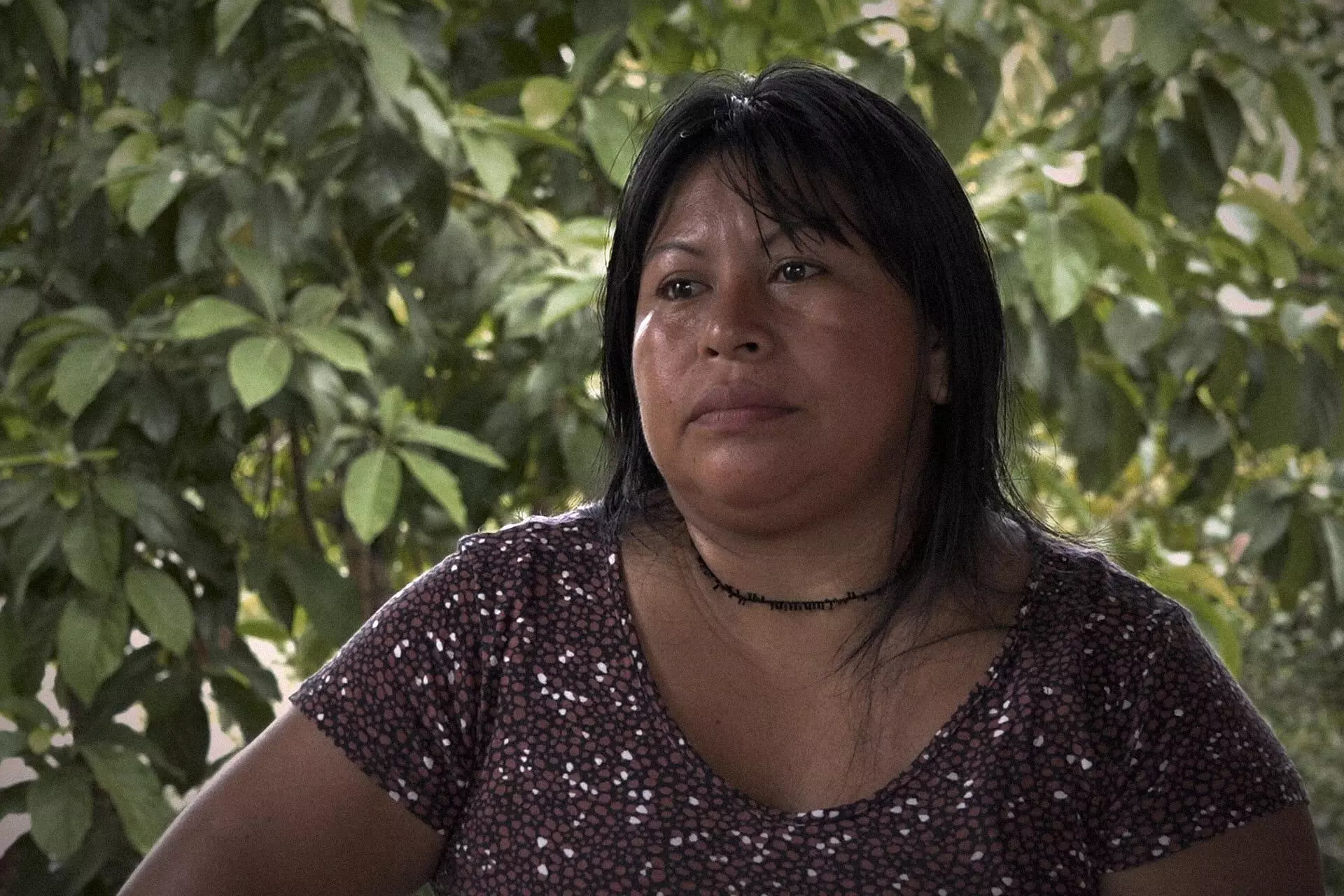
ALESSANDRA KORAP MAKES TWO IMMEDIATE DEMANDS OF LULA FOR HIS THIRD TERM IN OFFICE: ABOLISH ILLEGAL MINING OPERATIONS IN DEMARCATED AREAS, AND FINALLY DEMARCATE MUNDURUKU LANDS IN THE MIDDLE TAPAJÓS. PHOTO: PATRICK GRANJA
Like Maria Leusa—her friend and law school classmate at the Federal University of Western Pará (UFOPA)—Alessandra, first female president of the Pariri Munduruku Indigenous Association, which represents the thirteen Munduruku villages in the Middle Tapajós, has also received death threats because of her repeated denunciations not only of illegal mining operations but also of the theft of public lands through a scheme known as grilagem and the improper construction of hydroelectric power plants and ports. She was eventually forced to enter the Human Rights Defenders Protection Program for Pará State.
When we asked Alessandra whether she was optimistic about the new government, she expressed the same doubts we heard from all the Munduruku with whom we spoke: “From 2019 to 2022, because of President Bolsonaro’s declarations, accusations of improprieties soared. But even since Lula came to office, they’d been ‘letting the cattle through’ [a reference to former Environment Minister Ricardo Salles’s declaration that the Bolsonaro government would scale back environmental protections]. We have hopes he’ll take action.” Alessandra has two immediate demands to make of the new president: illegal mining must be abolished in demarcated Indigenous areas, and Munduruku lands in the Middle Tapajós must finally be demarcated, an object of dispute for some decades now.
The second demand will test the political will and true colors of the new government. Dilma Rousseff suspended the process of legal recognition of the 440,000 acres of Sawré Muybu Indigenous Territory, lying inside the municipality of Itaituba. Since then, governments have continued to drag their heels because of interest in building a series of dams along the Tapajós River—an aspiration also embraced by Bolsonaro. The São Luiz do Tapajós dam project is currently suspended, but if implemented would flood half of the Sawré Muybu reserve.
“A lot of projects are being shoved down our throats before all legal permits or ratifications have been cleared, like the Ferrogrão railway, bulk ports, and hydropower plants. The mayor of Itaituba himself pretends we don’t exist and at first said there were no Indigenous people in the region. They want to erase us to build these multinational projects. But we resist,” says Alessandra.
If the new Lula administration really wants to protect the Amazon, it must act now
As political powers-that-be and economic interests have opposed their cause not only under Bolsonaro but also under most Brazilian administrations, Indigenous peoples have turned increasingly to the courts for protection. Originally from Salvador but living in Santarém for the past six years, prosecutor Moreira Oliveira is one of a hard-hitting group of staff at the Federal Public Prosecutor’s Office who are striving to fight environmental crimes and human rights violations in the Amazon. The dismantling and underfunding of environmental agencies under the previous administration made more work for the Public Prosecutor’s Office. At our request, the office in Pará searched its databases of legal cases, using combinations of the keywords Munduruku, mining, gold, prospecting, and Small-Scale Mining License, in Portuguese. The searches returned twenty-nine results since 2013, of which twenty-three, or more than 80 percent, were initiated in 2019.
The survey identified a number of secret inquiries on the occurrence of individual environmental crimes involving deforestation and illegal mining. These investigations generally entailed federal operations meant to shut down mining activities. One such intervention, conducted in mid-2021, was baptized Mundurukânia. It is doubtful just how effective these operations are, as evinced by the skyrocketing growth of illegal mining in recent years. The main problem is that the interventions are carried out only sporadically and lack continuity. Even when an operation proves successful, mining activities are soon up and running again, since those implicated feel confident they won’t be bothered again any time soon.
These operations are also underfunded and often encounter opposition from local politicians. In the previous four years, former president Jair Bolsonaro himself had battled any effort to curb illegal mining. The Mundurukânia operation was a prime example: while the Federal Police called it a success—because they located five mining areas, destroyed six backhoes and ten suction pumps, broke up ten encampments, and seized 13,208 gallons of diesel oil—the endeavor was in fact hamstrung by the last-minute withdrawal of Armed Forces support. Some two hundred prospectors also reacted violently and tried to invade the base of operations at the Jacareacanga airfield to destroy equipment and aircraft belonging to the Federal Police, National Public Security Force, and Ibama. Suggestions are that the miners had been informed of the operation. Valmar Kaba, a local politician and deputy mayor of Jacareacanga, was arrested under suspicion of having incited the violence against operation personnel. In retaliation, Maria Leusa’s village was invaded and set fire to, clearly in hopes of intimidating anyone who challenges illegal mining. Not a single other police operation has taken place in the two years since.
Given the inefficacy of these sporadic operations, the Public Prosecutor’s Office launched a new strategy in 2021 in an attempt to curtail the gold trade. Based on a study done in partnership with the UFMG, the courts were asked to suspend all permits to extract, trade, and export gold in the southwestern area of Pará, encompassing the municipalities of Itaituba, Jacareacanga, and Novo Progresso, until such time as federal agencies have in place a reliable, effective system for verifying and monitoring these activities. In this same filing, prosecutors pointed out that they have been denouncing the problem for some time now “without any corrective measure having been timely or effectively adopted by the public authorities.”
These prosecutors lay the blame on federal oversight agencies; the federal government itself, the National Mining Agency (ANM), and Brazil’s Central Bank (Bacen) were all named as defendants in the case filed in 2021. According to the Public Prosecutor’s Office, it has been “proven that the defendants, through illegal and unconstitutional omission, promote the flooding of the market with gold of illegal origin, mined from Indigenous lands, and that they therefore condone the systematic, generalized practice of fraud known as gold laundering, while consigning Indigenous peoples to the threats and violence that stem from the greed and exploitational zeal of invaders, illegal mining concerns, and criminals.”
The Public Prosecutor’s Office lays out the measures that should be adopted by the defendants, starting with the expulsion of all invaders from Indigenous lands—a measure repeatedly ordered by the Federal Supreme Court since mid-2020 but never carried out. The office also calls for security forces to be assigned to the region of Jacareacanga municipality to guarantee the safety of Indigenous peoples who are part of the protection program for human rights defenders. The office has also suggested that ANM and Bacen should be tasked with designing and enforcing a system of certification of gold origin and traceability, along with the implementation of a system of electronically filed tax documents for reporting commercial transactions. But so far, more than a year and a half later, the judge still hasn’t examined the case, which remains at the district court in Itaituba.
Every day, prosecutors like Moreira Oliveira face the inertia of authorities who have the power, funds, and constitutional responsibility for enforcing the law. A current job requirement for employment at the Federal Public Prosecutor’s Office in the Amazon is the ability to not get discouraged. When Moreira Oliveira heard our reports about the appalling situation in Katõ Village, he requested a copy of our footage, which he then used to file another petition with the Federal Justice in Itaituba, asking them to order the urgent deployment of Federal Police forces to expel invaders from Munduruku lands. Until the time of publication, his request remained unanswered.
Brazil’s environmental legislation and laws protecting Indigenous peoples have earned global praise for being among the world’s most modern and boldest. But human laws do not enforce themselves; this depends on political will. For the last four years, Brazil was governed by political forces that in every way possible supported the violation of laws designed to protect the rainforest and its rivers and peoples, both human and nonhuman. The Munduruku people remains living proof of this crime. If the new Lula administration really wants to protect the Amazon, it must act now—not only by conducting flashy operations but by taking intelligent, responsible, and consistent action. It isn’t enough to kick the miners out; the government must guarantee that they will stay out. And rivers must be cleaned, the bodies of adults and children must receive care, Indigenous lands must be demarcated, and the Amazon must be reforested.
This report is the product of a partnership between SUMAÚMA and the Transnational Law Institute of King’s College London, under “The Laws of our Sustainable Future” project
Translated by Diane Whitty
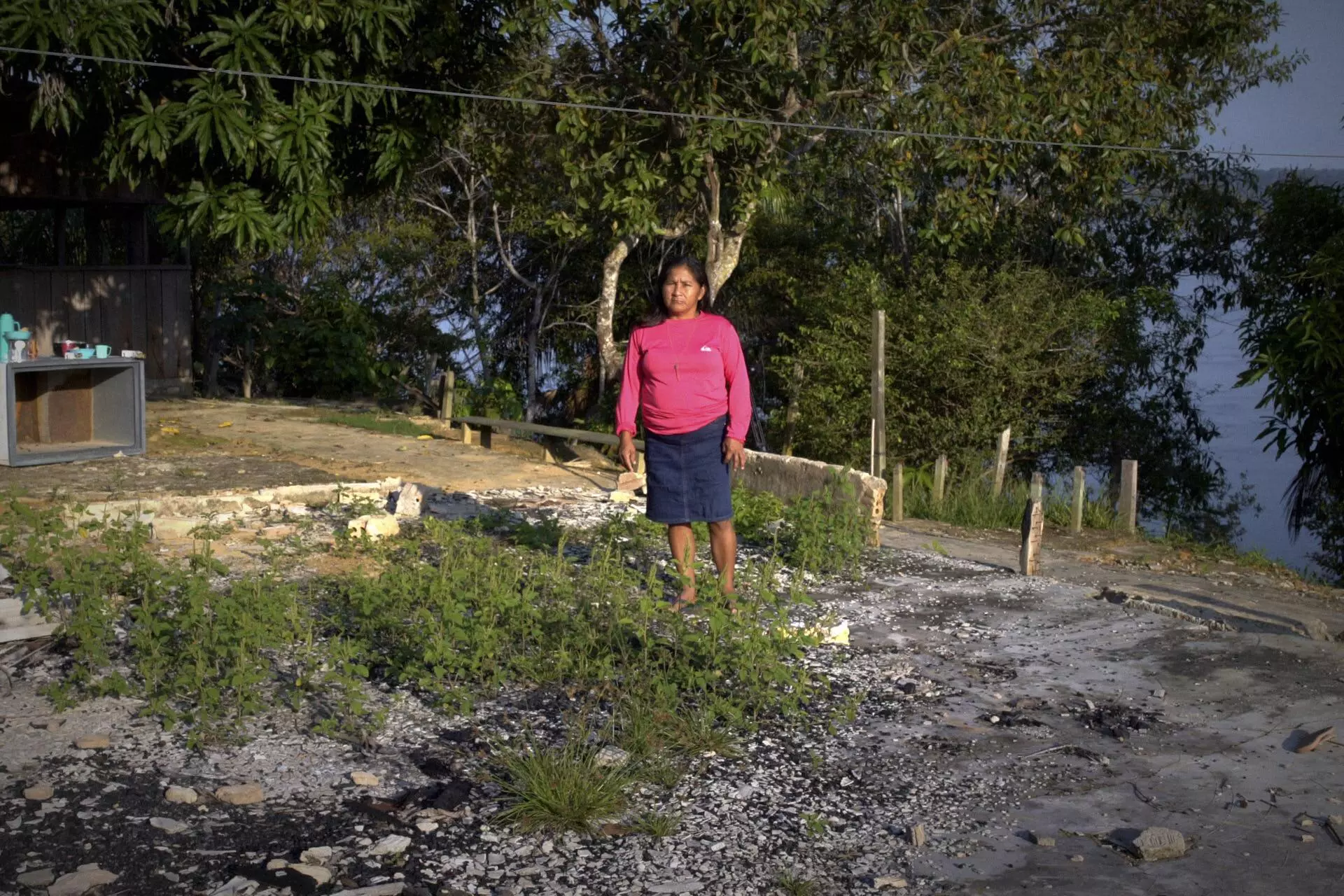
Indigenous leader Isaura in front of what is left of the house of one of her daughters, burned down by miners in the Fazenda Tapajós village, the same as Maria Leusa Kaba. Photo: Patrick Granja





